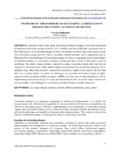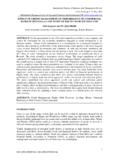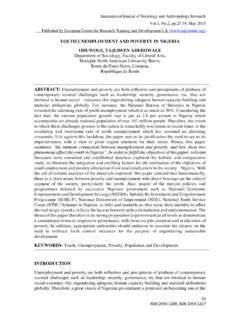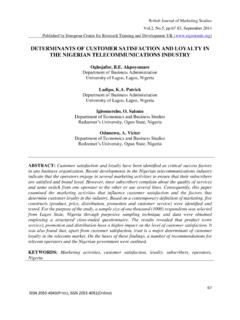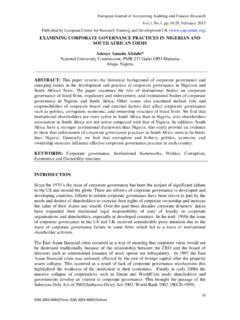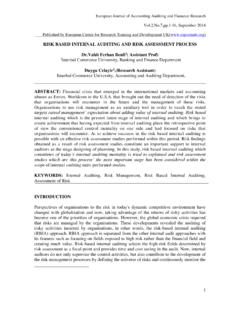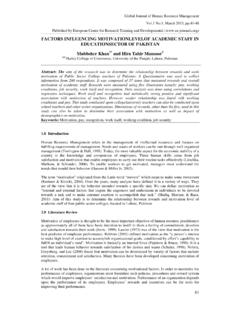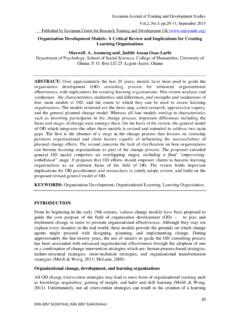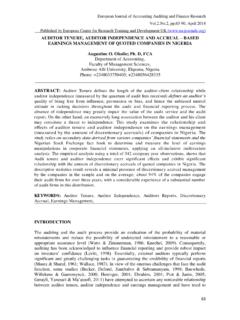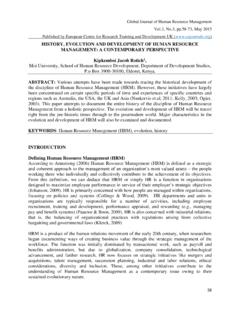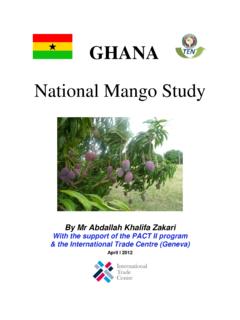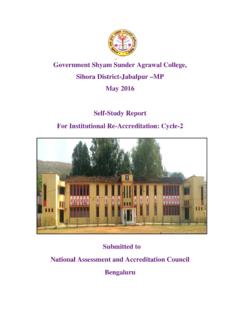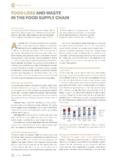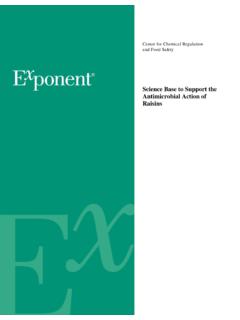Transcription of EVALUATION OF THE PERFORMANCE OF AGRICULTURAL …
1 European Journal of Agriculture and Forestry Research , , , May 2015 Published by European Centre for Research Training and Development UK ( ) 52 This study was carried out with funding from the Nigerian Economic Summit Group (NESG) Ltd ISSN 2054-6319 (Print), ISSN 2054-6327(online) EVALUATION OF THE PERFORMANCE OF AGRICULTURAL LENDING SCHEMES IN NIGERIA Obasi, P. C. Department of AGRICULTURAL Economics, Federal University of Technology, Owerri, P. M. B 1526 Owerri, Nigeria ABSTRACT: The broad objective of the study was to evaluate the PERFORMANCE of AGRICULTURAL lending schemes in Nigeria for the period 2009 - 2012.
2 The study was carried out in Benue, Kwara, Kaduna, Abia, Anambra, Rivers, and Ogun states respectively. The method of proportionate random sampling technique was used in selecting 185 borrowers who are registered with their state AGRICULTURAL Development Programmes (ADP s). The sampling frame comprised all the registered ADP farmers in the surveyed states who took bank loan. Data collected were analyzed using frequencies, percentages, means, and multiple linear regression analysis.
3 Results of the analysis showed that during the period 2009 - 2012, a total of 27,987 farmers applied for bank loan in Nigeria totalling N13,704,965, , while 21,490 farmers were granted loan facility during the same period which totalled N7,188,575, leaving a credit supply gap of N6,516,390, The total amount of loan repaid by borrowers during the same period was N3, 523,018, which gave a repayment rate of 49% and a default rate of 51%. The loan granted to borrowers increased national output by , and impacted positively on the income of borrowers.
4 It was recommended that the government should continue to encourage increased funding to the AGRICULTURAL sector for accelerated food production in Nigeria by small and medium scale farmers through the provision of institutional loans to these categories of farmers using ACGSF and CACS. KEYWORDS: EVALUATION , PERFORMANCE , Lending Schemes, Nigeria INTRODUCTION In Nigeria the provision of institutional credit to small holder farmers has been the policy thrust of successive governments.
5 The first attempt at the injection of financial capital into the AGRICULTURAL subsector in Nigeria was made by the Federal Government in the 1962 1968 development plan with the provision of six million naira (N6m) for the development of that sector of the economy (FMED, 1981). Following this, bank credits to the AGRICULTURAL sector in nominal terms over the years increased from N230 million (then about $233 million) in 1978 to over N262 billion ($ billion) in 2005 (CBN, 2010 a). This is in realization of the fact that to sufficiently boost food production and adopt new AGRICULTURAL technologies and European Journal of Agriculture and Forestry Research , , , May 2015 Published by European Centre for Research Training and Development UK ( ) 53 This study was carried out with funding from the Nigerian Economic Summit Group (NESG) Ltd ISSN 2054-6319 (Print), ISSN 2054-6327(online)
6 Innovations, there is the need for farmers to borrow money from lending institutions (Obasi et al, 1995). Moved by the desire to reduce import dependency, as well as by the need to relieve dependence on the oil sector for economic growth, Federal and state governments stepped up efforts to promote AGRICULTURAL development through the establishment of a number of AGRICULTURAL credit schemes. These schemes include the AGRICULTURAL Credit Guarantee Scheme Fund (ACGSF), the Special Emergency AGRICULTURAL Loans Scheme (SEALS), the Supervised AGRICULTURAL Credit Scheme (SACS), the Small and Medium Enterprises Equity Investment Scheme (SMEEIS), the AGRICULTURAL Credit Support Scheme (ACSS), and the Commercial AGRICULTURAL Credit Scheme (CACS), and recently the Nigerian Incentive based Risk Sharing system for AGRICULTURAL Lending (NIRSAL).
7 The NIRSAL though not a scheme at such, encourages farmers to insure their farms against natural disaster, and to borrow from commercial banks guaranteeing the interest paid by the farmer up to 60%. According to Central Bank of Nigeria (CBN)(2010b), between 1978 and 1989 when the government stipulated lending quotas for banks under the Schemes, there has been consistent increase in the lending portfolios of banks to the AGRICULTURAL subsector. For instance, between 1996 and 2011,the amount of loan granted under the ACGSF increased from N225, to N7,623, with the highest amount of N8,349, being disbursed in 2009(CBN)(2010b).
8 However, experience gained from the implementation of these schemes show that although they have succeeded in increasing the level of funding to the AGRICULTURAL sector, the impact has not been as significant as anticipated, and moreover, the successes recorded have almost in all cases been constrained by among others, poor loan repayment PERFORMANCE , late disbursement of loans, loan diversion, low output, low productivity, and reluctance on the part of formal lending institutions to finance AGRICULTURAL production (Njoku and Obasi, 1991).
9 However, the repayment of formal institutional loans by farmers in Nigeria has become such a problem that it has constituted a serious constraint hampering loan mobilization and disbursement in the formal financial markets in Nigeria (Eweka et al, 1979). The repayment problem has manifested itself in the unwillingness of formal financial institutions to grant loan facilities to the AGRICULTURAL subsector of the economy which it considers a high investment risk area.
10 These therefore suggest that the schemes have been inefficient in fund delivery and recovery. As a result, there is the need therefore for research to evaluate the PERFORMANCE of the various lending schemes in Nigeria, with a view to deriving policy for better PERFORMANCE . Objectives of the study The broad objective of the study was to evaluate the PERFORMANCE of AGRICULTURAL lending schemes in Nigeria for the period 2009 - 2012. The specific objectives of the study are to: (i) examine the socio-demographic characteristics of farmer borrowers in Nigeria for the period under review (ii) ascertain the various AGRICULTURAL lending schemes in Nigeria and the procedure for obtaining bank loan in the country European Journal of Agriculture and Forestry Research , , , May 2015 Published by European Centre for Research Training and Development UK ( ) 54 This study was carried out with funding from the Nigerian Economic Summit Group (NESG)
